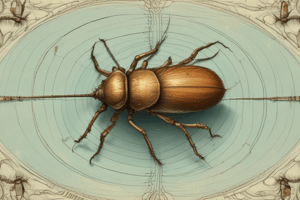Podcast
Questions and Answers
Ticks can grow up to 3 cm when soaked and are of special importance in veterinary and human medicine because of their function as transmitters of major diseases. According to their morphology and biology, ticks are separated into two families: 1. Soft ticks (Argasidae) 2. ______ (Ixodidae)
Ticks can grow up to 3 cm when soaked and are of special importance in veterinary and human medicine because of their function as transmitters of major diseases. According to their morphology and biology, ticks are separated into two families: 1. Soft ticks (Argasidae) 2. ______ (Ixodidae)
Hard ticks
Each stage is completed with a moult being essential for further growth. To find their host, both tick families use a set of chemoreceptors located along their forelegs, in particular in an organized group of them called the Haller’s organ. ______—Soft ticks Otobius megnini Epidemiology The Argasid (soft) tick Otobius megnini, the spinose ear tick, infects cattle, sheep, dogs, horses and occasionally people in and North America, including Canada, as well as South America, India, and South Africa. Morphology Adults are blue grey in color with yellow legs and mouthparts. Adult females measure 5-8 mm and males are slightly smaller. Engorged nymphs measure 7-10 mm and are covered with short yellow spines. Larva are 2-3 mm in length with 9-10 pairs of setae on the dorsal surface and 5 pairs on the ventral surface. Geographic distribution of spinose ear tick Otobius megnini Life Cycle Otobius megnini is a one-host tick with larval and nymphal stages parasitic and the adult stage non-parasitic.
Each stage is completed with a moult being essential for further growth. To find their host, both tick families use a set of chemoreceptors located along their forelegs, in particular in an organized group of them called the Haller’s organ. ______—Soft ticks Otobius megnini Epidemiology The Argasid (soft) tick Otobius megnini, the spinose ear tick, infects cattle, sheep, dogs, horses and occasionally people in and North America, including Canada, as well as South America, India, and South Africa. Morphology Adults are blue grey in color with yellow legs and mouthparts. Adult females measure 5-8 mm and males are slightly smaller. Engorged nymphs measure 7-10 mm and are covered with short yellow spines. Larva are 2-3 mm in length with 9-10 pairs of setae on the dorsal surface and 5 pairs on the ventral surface. Geographic distribution of spinose ear tick Otobius megnini Life Cycle Otobius megnini is a one-host tick with larval and nymphal stages parasitic and the adult stage non-parasitic.
Argasidae
Adults are blue grey in color with yellow legs and mouthparts. Adult females measure 5-8 mm and males are slightly smaller. Engorged nymphs measure 7-10 mm and are covered with short yellow spines. Larva are 2-3 mm in length with 9-10 pairs of setae on the dorsal surface and 5 pairs on the ventral surface. Geographic distribution of spinose ear tick ______ Life Cycle ______ is a one-host tick with larval and nymphal stages parasitic and the adult stage non-parasitic.
Adults are blue grey in color with yellow legs and mouthparts. Adult females measure 5-8 mm and males are slightly smaller. Engorged nymphs measure 7-10 mm and are covered with short yellow spines. Larva are 2-3 mm in length with 9-10 pairs of setae on the dorsal surface and 5 pairs on the ventral surface. Geographic distribution of spinose ear tick ______ Life Cycle ______ is a one-host tick with larval and nymphal stages parasitic and the adult stage non-parasitic.
Otobius megnini
Otobius megnini is a one-host tick with larval and nymphal stages parasitic and the adult stage ______.
Otobius megnini is a one-host tick with larval and nymphal stages parasitic and the adult stage ______.
The Argasid (soft) tick Otobius megnini, the spinose ear tick, ______ cattle, sheep, dogs, horses and occasionally people in and North America, including Canada, as well as South America, India, and South Africa.
The Argasid (soft) tick Otobius megnini, the spinose ear tick, ______ cattle, sheep, dogs, horses and occasionally people in and North America, including Canada, as well as South America, India, and South Africa.
Flashcards are hidden until you start studying
Study Notes
Ticks
- Ticks can grow up to 3 cm when soaked and are important in veterinary and human medicine due to their role in transmitting major diseases.
Classification of Ticks
- Ticks are separated into two families based on morphology and biology: Soft ticks (Argasidae) and Hard ticks (Ixodidae).
Lifecycle
- Each stage of a tick's lifecycle is completed with a moult, which is essential for further growth.
Host-Finding Mechanism
- Both soft and hard ticks use chemoreceptors located along their forelegs, particularly in the Haller's organ, to find their hosts.
Otobius megnini (Spinose Ear Tick)
Morphology
- Adults are blue grey in color with yellow legs and mouthparts.
- Adult females measure 5-8 mm and males are slightly smaller.
- Engorged nymphs measure 7-10 mm and are covered with short yellow spines.
- Larvae are 2-3 mm in length with 9-10 pairs of setae on the dorsal surface and 5 pairs on the ventral surface.
Geographic Distribution
- Found in North America, including Canada, as well as South America, India, and South Africa.
Life Cycle
- Otobius megnini is a one-host tick with larval and nymphal stages parasitic and the adult stage non-parasitic.
Hosts
- Infects cattle, sheep, dogs, horses, and occasionally people.
Studying That Suits You
Use AI to generate personalized quizzes and flashcards to suit your learning preferences.




